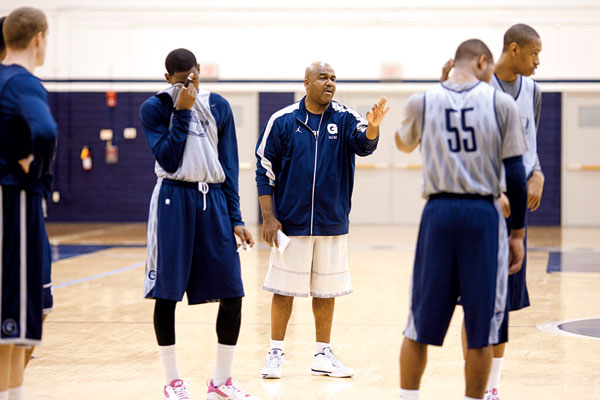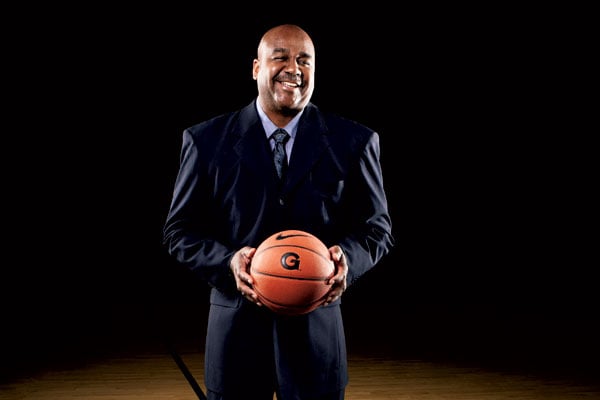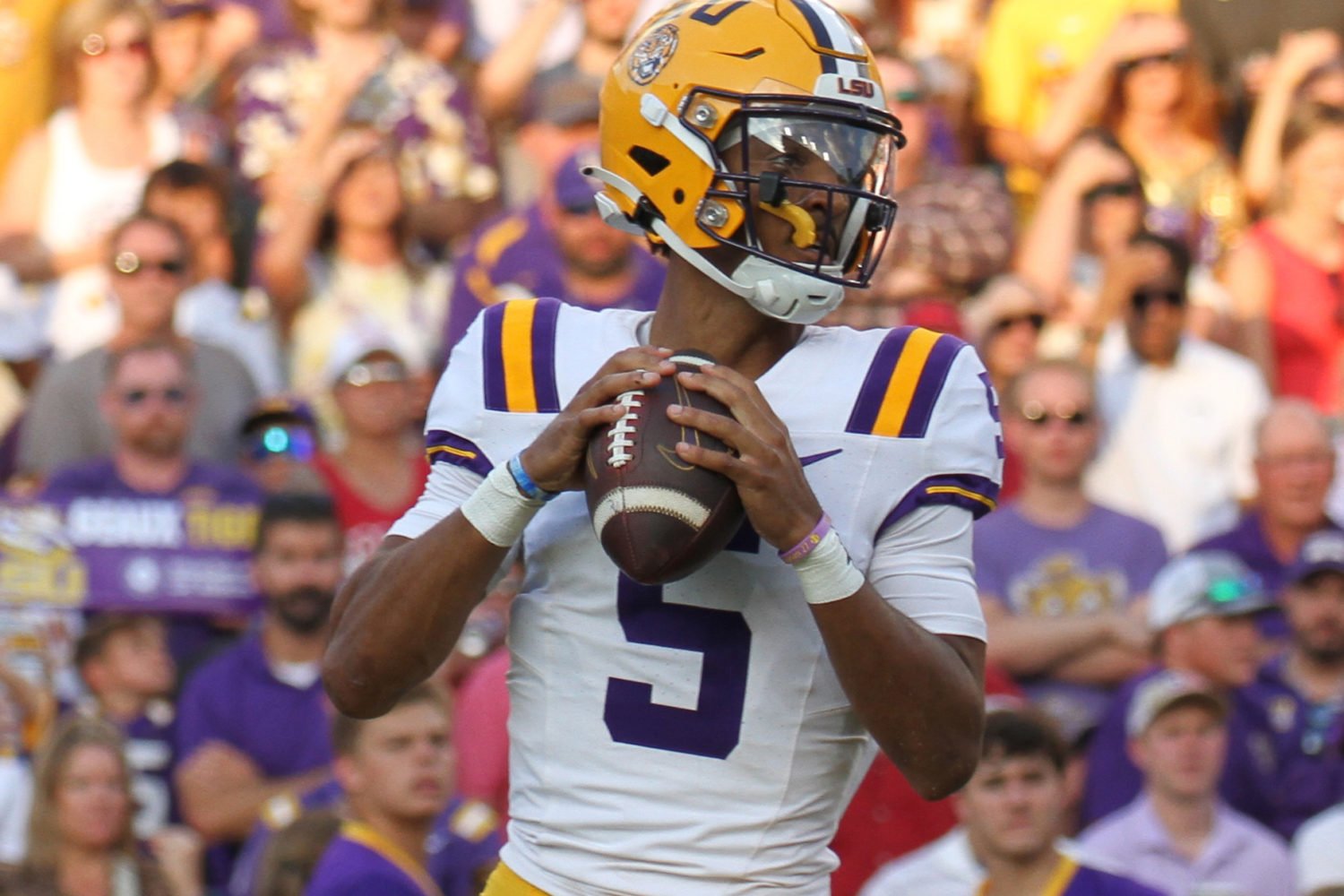
The Princeton offense Thompson deploys is based on passing and constant motion. Photograph by Melissa Golden.
There may not be a more apt way to describe Thompson–comfortable in his own skin. Each day when he arrives at work, he walks through the ornate John Thompson Lobby of McDonough Arena to his office. On the way, he passes a display of the many trophies his father’s teams won over the years alongside a bust of his father’s head in bronze.
Yes, Thompson literally has to walk past a monument to his father to get to his office each day.
“It’s nothing to run from,” John III says. “It’s part of who I am. He was one of the best that ever did it. Do people compare and contrast me to him more because I’m here? Probably. But I’ve been John Thompson’s son my whole life. I’m pretty comfortable with him.”
He needs to be. His father isn’t just a vague presence in Georgetown basketball history. He’s an actual presence–in the building almost every day. He has an office at McDonough and retains both a $500,000 salary and an official title from the university: special assistant to the president and coach emeritus.
When he comes to practice, the elder Thompson stays out of the way. He waits until the session has started before he enters and he often sits in a wooden chair in front of the collapsible bleachers, his back pressed against the wall as if trying to blend into the woodwork.
Yet his presence is felt.
“He was here every practice,” says Jeff Green. The former Hoyas star is now with the Boston Celtics but is recovering from surgery to repair an aortic aneurysm. “He took notes, and when we were done we’d walk past and shake his hand and he told us hello, and he would give us his piece,” Green says.
When asked if his son likes having him at practice, the elder Thompson says, “I don’t care if he likes it or not. He lets me in there. I very seldom say anything to him at practice. I just sit there and watch because I enjoy it.”
To see John III at work is to see a man so self-possessed that he’d likely be at ease if basketball inventor James Naismith himself were watching his practices. But when it comes to his father, the younger Thompson says it’s not a question of his own comfort: “That man has earned the right to do whatever the heck he wants.”
The bedsheet unfurled from the stands during a game in February 1975. “Thompson the nigger flop must go,” it said.
It was the elder Thompson’s third season at Georgetown, a decade before he would become the first African-American head coach to win the NCAA championship.
John III was a month shy of his ninth birthday. These were the lean beginnings of his father’s tenure at Georgetown. The elder Thompson had inherited a program that had won just three of 26 games in its final season under his predecessor, Jack Magee.
John Thompson Jr.–known to friends and family as Pops, Big John, or Coach–had grown up in public housing in DC and was a star player at Archbishop Carroll High School, leading the team to an undefeated season in 1960, his senior year.
Thompson was an All-American at Providence College and made it to the NBA, where he had a short and undistinguished career. He played two seasons for coach Red Auerbach in Boston and arguably lasted that long only because he was tall–six-foot-ten. He earned the nickname the Caddy because his lot in life with the Celtics was to back up future hall-of-famer Bill Russell. John was traveling with the Celtics when John III, his first son, was born; his wife, Gwen, drove herself to the hospital, according to a 2005 article in the Washington Post.
The Celtics won the NBA championship both seasons Thompson was on the roster, but when the Chicago Bulls joined the league in 1966, the Celtics left Thompson unprotected in the expansion draft. The fledgling franchise from the Windy City selected his rights, but instead of moving to Chicago Thompson came home to Washington and became head coach at St. Anthony high school in Northeast DC.
He arrived at Georgetown in 1972 following an exceptional six-year run at St. Anthony–his teams went 122-28–but he had no experience coaching at the college level. When he failed to produce a winning record his first two seasons at Georgetown, skepticism grew. At the time of the bedsheet incident, the Hoyas had just come off a six-game losing streak. They won that game by 42 points, and they would win all but one of their remaining games that season to finish 18-10. Georgetown finished each of the next 22 seasons with no fewer than 19 wins.
John III and his younger siblings, Ronny and Tiffany, bore witness to their father’s missteps and the milestones. The kids, however, didn’t get the kind of special treatment one might expect the children of emerging basketball royalty to enjoy.
“My kids didn’t come over to school and sit at people’s desks and run around my office,” the elder Thompson says. “It wasn’t like all of a sudden the king’s kids are here. I made them respect that.” It was part of the Thompsons’ parenting philosophy: Don’t exploit who you are, but don’t deny it, either.
“You want to look at me and ask what it was like being the son of John Thompson, the coach of Georgetown, and I don’t have another point of reference,” says John III. “It was just my life.”
Young John defused his father’s celebrity, and his friends in the Michigan Park neighborhood of Northeast DC–where the family lived–followed suit.
“We saw John as John,” says Mark Tillman, a childhood friend. “Yeah, we knew who his dad was, but growing up around him and going to his house all the time, it wasn’t like ‘Wow, that’s Coach John Thompson from Georgetown.’ He was just another typical dad who lived in the neighborhood, and John was just his son.”
Tillman notes that in those days most everyone referred to the younger Thompson as John or JT. The moniker JT3 seems to have been created by the media following his arrival at Georgetown. Few close to him use it.
When John Thompson III’s parents enrolled him at Gonzaga, head coach Dick Myers was giddy over the prospect of the six-foot-two freshman with the size-13 shoes. Sadly, Myers recalls, when he graduated four years later Thompson still had a size-13 shoe and he was still six-foot-two. “I never forgave him for that.”
Thompson may not have grown in stature under Myers, but his skills and leadership blossomed. In the spring of 1984, he was selected to the All-Met team by the Washington Post.
Myers, who coached Gonzaga for 29 seasons before retiring in 2004, says Thompson was one of the smartest and most insightful players he ever coached. “He was a very cerebral player,” his teammate Byron Harper says. “Not very athletic but definitely a student of the game. While most guys were out there playing checkers, he was playing chess.”


















